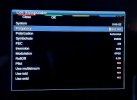To try and clear things up...
For a given power level & FEC, a DVB-S2 transponder broadcasting with 8PSK modulation will require a higher signal to noise (SNR) ratio to successfully decode transmissions than if it was QPSK modulation (either DVB-S or DVB-S2).
This simply means the receiver requires a stronger SNR, not that the transmitted signal power is inherently weaker!
Prior to the adoption of DVB-S2, when it was DVB-S only, only the FEC could be changed to allow whoever was transmitting on a transponder to increase the bitrate (all other things being equal e.g. Symbol rate). With the introduction of DVB-S2, three additional modulation modes were added - 8PSK, 16APSK & 32APSK though only 8PSK is used for regular broadcasts to home users, each modulation value having pros & cons as to their usability for transmission.
In the case of the transponders that at 28 degrees east been converting to DVB-S2 since the start of the year, they mostly (but not all) converted from DVB-S FEC-5/6 to DVB-S2 8PSK FEC-2/3. The SNR required for the former is 6.5db while the latter is 6.6db - essentially no real difference as far as reception goes.
DVB-S2 8PSK transmissions are used on geostationary satellites across the Clarke Belt, serving across the world, for over 15 years now. It's a very mature & well tested mode of transmission.



